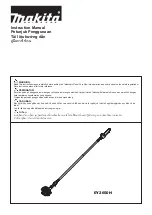
13 ENGLISH
properly follow your intended cut line, do not attempt
to turn or force the tool back to the cut line. Doing so
may bind the circular saw blade and lead to dangerous
kickback and possible serious injury. Release switch,
wait for circular saw blade to stop and then withdraw
tool. Realign tool on new cut line, and start cut again.
Attempt to avoid positioning which exposes operator to
chips and wood dust being ejected from saw. Use eye
protection to help avoid injury.
Hook
CAUTION:
Always remove the batteries when
hanging the tool with the hook.
CAUTION:
Never hook the tool at high loca-
tions or on the surfaces where the tool may lose
the balance and fall.
CAUTION:
Do not pull the tool hooked
downward.
The hook is convenient for hanging the tool temporarily.
To use the hook, simply lift up hook until it snaps into
the open position.
When not in use, always lower hook until it snaps into
the closed position.
1
►
1.
Hook
Rip fence (Guide rule)
Optional accessory
The handy rip fence allows you to do extra-accurate
straight cuts. Simply slide the rip fence up snugly
against the side of the workpiece and secure it in posi-
tion with the clamping screw on the front of the base. It
also makes repeated cuts of uniform width possible.
1
2
►
1.
Rip fence (Guide rule)
2.
Clamping screw
Lanyard (tether strap) connection
Safety warnings specific for use at height
Read all safety warnings and instructions.
Failure
to follow the warnings and instructions may result in
serious injury.
1.
Always keep the tool tethered when working
"at height". Maximum lanyard length is 2 m
(6.5 ft).
2.
Use only with lanyards appropriate for this tool
type and rated for at least 6.5 kg (14.4 lbs).
3.
Do not anchor the tool lanyard to anything on
your body or on movable components. Anchor
the tool lanyard to a rigid structure that can
withstand the forces of a dropped tool.
4.
Make sure the lanyard is properly secured at
each end prior to use.
5.
Inspect the tool and lanyard before each use
for damage and proper function (including
fabric and stitching). Do not use if damaged or
not functioning properly.
6.
Do not wrap lanyards around or allow them to
come in contact with sharp or rough edges.
7.
Fasten the other end of the lanyard outside
the working area so that a falling tool is held
securely.
8.
Attach the lanyard so that the tool will move
away from the operator if it falls.
Dropped tools
will swing on the lanyard, which could cause injury
or loss of balance.
9.
Do not use near moving parts or running
machinery.
Failure to do so may result in a crush
or entanglement hazard.
10.
Do not carry the tool by the attachment device
or the lanyard.
11.
Only transfer the tool between your hands
while you are properly balanced.


































